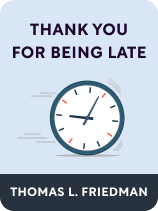

This article is an excerpt from the Shortform book guide to "Thank You for Being Late" by Thomas L. Friedman. Shortform has the world's best summaries and analyses of books you should be reading.
Like this article? Sign up for a free trial here .
How has the state of the workforce changed over the years? What are the main factors responsible for the changes? What can we do to adapt?
According to Thomas Friedman, the author of Thank You for Being Late, globalization and the increasing interconnectedness of the world have resulted in eight fundamental changes in the state of the workforce. Further, the future of the workforce depends on how well we can adapt to these changes.
Keep reading for the eight changes that transformed the state of the workforce and the three ways we can adapt.
The Historical State of the Workforce
In the 19th century, most Americans were farmers. After the Industrial Revolution, trade guilds disappeared, and in the 20th century, most people worked in factories or office jobs.
By the ‘90s, you could reach middle-class if you just worked hard and followed all the rules—well-paying jobs only required average skills. If you worked 40 hours a week you could buy a house, afford to have children, go on vacation, and retire. This was because, after World War II, there were lots of manufacturing jobs, there was little outsourcing or international competition for jobs, and people switched jobs less frequently, so companies put in the resources to train them. Acceleration was slower, so your education was relevant for longer, and technology wasn’t powerful enough to start taking over jobs.
Additionally, back then, not everyone had internet access—there were probably hundreds of thousands of people in the world who could do your job, but because they didn’t have a way to access your job, you didn’t have to compete with them.
Current State of the Workforce
According to Thomas Friedman, the future of the workforce depends on how well we can adapt to these eight fundamental changes:
Change #1: Middle-class jobs now require more education and knowledge, and the increasing requirement for bachelor’s degrees bars a lot of people from middle-class jobs. (A degree isn’t necessarily indicative of your skills or perfectly matched to a job description—for example, 65% of postings for executive assistants and secretaries require a bachelor’s degree, and 71% of people currently working these jobs don’t have a bachelor’s degree.) Today, to be part of the middle class, you have to work harder, participate in lifelong learning (at best, your education prepares you for your first job), and deal with shifting employment regulations.
- For example, today, dairy farmers equip their cows with transponders, which keep track of each cow’s milking speed, amount of milk produced, and number of steps taken per day. The job of cow milker now requires some familiarity with transponders.
Change #2: Single jobs are being split into high- and low-skilled jobs. The high-skilled part will require more skill and pay better, and the low-skilled part will be automated or paid minimum wage.
- The job of cow milker may become two jobs. The low-skilled part of the job—herding and shoveling manure—could become a minimum wage job that requires no education. The high-skilled part—knowing when and how best to milk a cow—might require new skills such as big data analysis or veterinary knowledge.
Change #3: There’s more competition for jobs, either with international workers or automation. Now that more people have internet access and everyone has access to the same information, geographical location no longer matters as much. The only difference among candidates is motivation.
Change #4: To continue existing, jobs need to fit into new niches or take advantage of new opportunities. Automation will only take over if we fail to rethink the workforce.
Change #5: While some jobs will become partly automated, most jobs won’t disappear, and according to a paper by economist James Bessen, industries with higher use of computers actually increase the number of available jobs.
- For example, in the 19th century, weaving cloth became 98% automated. As a result, it became much faster to make cloth and prices went down, which increased demand. People not only bought more clothes, but they also bought other fabric products like curtains or upholstery. Demand increased so much that the number of weaving jobs actually increased, in spite of the fact that most of the manual labor was being done by machines.
Change #6: Technology can change what tasks are necessary in certain occupations and can transfer tasks between occupations.
- For example, taking messages used to be done by telephone operators. Now, it’s part of a receptionist’s duties. While the number of telephone operators has declined since 1980, the number of receptionists has increased since 1980.
Change #7: Some jobs will completely disappear.
- For example, no one works as a lamplighter or horse-and-buggy driver anymore.
Change #8: “Stempathy” jobs are the jobs of the future. “Stempathy” jobs are jobs that require both technical (science, technology, engineering, and math) and people (empathy) skills. Since the 1980s, the number of jobs that require people skills has grown, and the jobs that require both people skills and cognitive skills have increased in salary since 2000. This is because jobs that only require technical skills are usually possible to automate, and jobs that only require people skills can be done by lots of people, so the pay is low.
- For example, recall Watson, the cognitive computer that helps doctors. While Watson can diagnose, the doctor is the one who has to deliver the news to the patient and comfort them. Technology will never be able to replace or automate human empathy.
Skills Gap
There are jobs for which it’s hard to find employees with the right skills, and in the age of accelerations, those skills are usually related to their proficiency with technology. There can be a gap between available jobs and enough skilled workers to fill them for three reasons:
- The demand for a certain skill sometimes shoots up overnight—faster than schools can teach it—so it takes a while for people to get trained.
- People who have the right skills but don’t have formal credentials are weeded out by employers’ hiring systems. The current job market is designed to narrow down the flood of candidates employers have to consider, not to match people and their skills with jobs.
- People who have the skills don’t know the job exists because there’s no good system in existence to match people and their skills with jobs.
Adapting
To adapt to these accelerating times, we need to rethink the workplace by: 1) establishing lifelong learning programs, 2) building tools to help match people and their skills to jobs, and 3) revising social contracts.
Lifelong Learning Programs
Lifelong learning—constantly learning new things to keep up with the accelerations—is an inevitable part of the future and several companies have built platforms or programs to support it. Ideally, these platforms will be able to keep up with the three accelerations so that as soon as there’s a change, resources on how to adapt to that change are quickly available.
Example #1: Udacity offers online courses on, among other things, brand-new technology. In October 2015, Google released TensorFlow—a set of algorithms that work with big data—to the public. Only three months later, Udacity released a course on how to use TensorFlow that they’d put together with the help of Google engineers. It would take a traditional college at least a year to put together a course.
Example #2: Olin College is a brick-and-mortar college, but its programs are flexible in order to keep up with accelerations. Faculty members don’t have tenure, there are no academic departments, and the curriculum expires every seven years. Additionally, all students must work with a corporate sponsor for a year on a project. All of these elements help keep education relevant in a changing world.
Tools to Match People to Jobs
The author covers four tools that can help match people and their skills to jobs, all of which have the acronym IA:
1. Intelligent assistance is creating platforms that allow everyone in the world to pursue professional development and then use that development to get jobs.
- For example, AT&T realized that they needed to retrain or redistribute a lot of their employees because they didn’t have the skills needed for the accelerating world. AT&T built an internal database of employees’ skills, similar to LinkedIn. Whenever a job opened up, HR could search the system for people who had matching skills. Additionally, the job post specified what skills were needed for the job and explained where to get training for those skills. (AT&T partnered with several schools to create affordable training—think $6,600 for a master’s degree.)
2. Intelligent assistants are software programs that teach people about job-hunting.
- For example, LearnUp.com is a website that teaches people how to get entry-level jobs. People who don’t have a network—didn’t go to college, don’t have friends in the industry, and so on—don’t have any way to learn how job hunting works or how to keep a job. LearnUp.com collects real job postings, and then teaches applicants, using video, the skills that are required for those jobs. LearnUp also has a coaching function. The coach is an intelligent assistant that can answer common questions, give directions to a job interview, and remind you to send your interviewer a thank-you note, among other things.
3. Intelligent advice is analyzing patterns in the school system or workforce.
- For example, the College Board shares the results of students’ practice tests (with permission) with college advisors so that the advisors can take trends into account as well as an individual student’s results when recommending AP classes or scholarship opportunities.
4. Intelligent algorithms help skilled people find jobs that require their skills. They also help job seekers find out what skills they need to get jobs and where they can get those skills.
- For example, Opportunity@Work tests people who have tech skills but no formal credentials. Opportunity@Work then certifies them, connects them with employers, and/or points them towards more training.
Rewriting Social Contracts
The relationships between workers, schools, companies, and the government need to change to adapt to the age of accelerations. In the past, land or physical goods were the most valuable asset to the economy, but now, the world’s population—everyone’s skills, creativity, and knowledge—are most valuable.
Three social contracts need to be rewritten, those between:
- Bosses and workers. Bosses need to hire people based on their skills, not their credentials, and companies need to provide access and funding for lifelong learning. Workers, for their part, need to engage with the opportunities that their bosses provide and work hard. This new relationship will increase employee engagement, morale, and the skill level of a company’s workers.
- Schools and students. Schools need to better prepare their students for a constantly changing world—they need to revise their curricula quickly and teach up-and-coming skills. Online education is doing this well and traditional colleges and universities need to match pace. Additionally, schools should place more of a focus on social skills—soft skills are what distinguish people from machines.
- Governments and citizens. Governments need to offer incentives to companies to build the tools to match people to jobs.
Where We’re Headed
The workforce is changing fast and the current era is ending, but while the transition will be bumpy, the new workplace might be better. In a workplace with a platform that would match people and their skills to jobs:
- People would have more autonomy and flexibility.
- People would have jobs or projects that align with their skills and interests.
- People could quickly and easily find out where they could learn new skills if they were so inclined.
- People would be treated more fairly—the platform might eliminate bias.

———End of Preview———
Like what you just read? Read the rest of the world's best book summary and analysis of Thomas L. Friedman's "Thank You for Being Late" at Shortform .
Here's what you'll find in our full Thank You for Being Late summary :
- The problems that arise when the world changes faster than humanity can adapt
- How to adapt to technology, globalization, and climate change
- The importance of taking time to reflect and reorient






